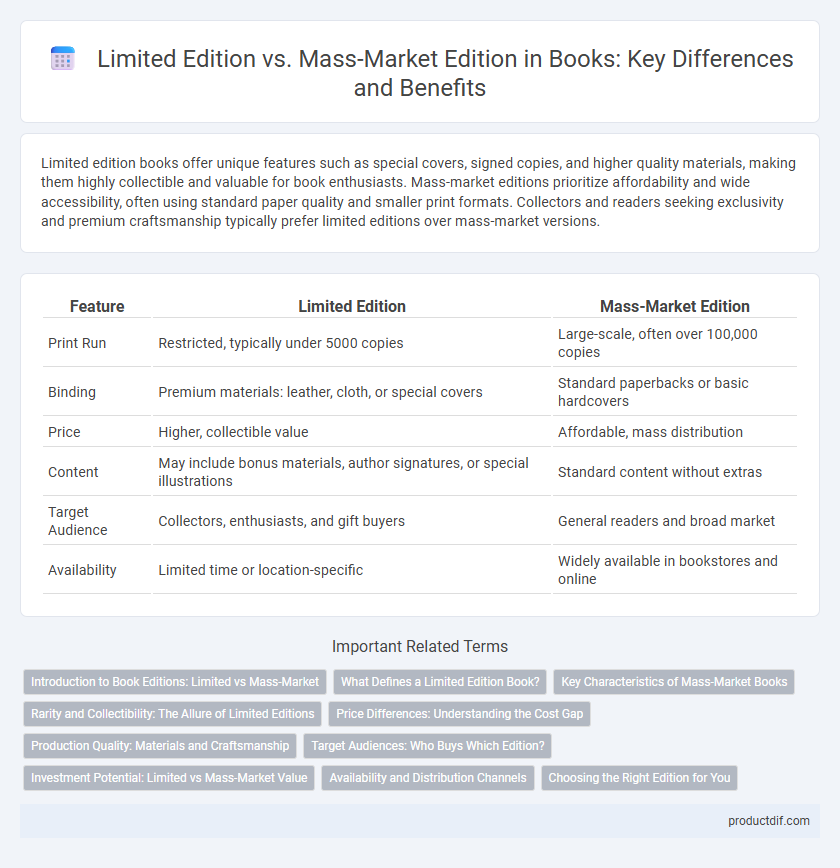Limited edition books offer unique features such as special covers, signed copies, and higher quality materials, making them highly collectible and valuable for book enthusiasts. Mass-market editions prioritize affordability and wide accessibility, often using standard paper quality and smaller print formats. Collectors and readers seeking exclusivity and premium craftsmanship typically prefer limited editions over mass-market versions.
Table of Comparison
| Feature | Limited Edition | Mass-Market Edition |
|---|---|---|
| Print Run | Restricted, typically under 5000 copies | Large-scale, often over 100,000 copies |
| Binding | Premium materials: leather, cloth, or special covers | Standard paperbacks or basic hardcovers |
| Price | Higher, collectible value | Affordable, mass distribution |
| Content | May include bonus materials, author signatures, or special illustrations | Standard content without extras |
| Target Audience | Collectors, enthusiasts, and gift buyers | General readers and broad market |
| Availability | Limited time or location-specific | Widely available in bookstores and online |
Introduction to Book Editions: Limited vs Mass-Market
Limited edition books feature exclusive content, high-quality materials, and are produced in small quantities to enhance collectability and value. Mass-market editions prioritize affordability and wide distribution, typically using lower-cost paper and simpler designs to reach a broader audience. Understanding the distinctions between these editions helps readers and collectors make informed decisions based on rarity, price, and presentation.
What Defines a Limited Edition Book?
A limited edition book is defined by its restricted print run, often numbered and signed by the author or illustrator, enhancing its exclusivity and collectible value. These editions feature high-quality materials, such as premium paper, special bindings, and unique cover designs, distinguishing them from mass-market editions. Collectors and enthusiasts seek limited editions for their rarity, artistic presentation, and potential appreciation in value.
Key Characteristics of Mass-Market Books
Mass-market books are typically smaller in size, printed on lower-quality paper, and feature softcover bindings designed for affordability and widespread distribution. These editions often have large print runs, making them easily accessible in bookstores, supermarkets, and airports. Their compact format and budget-friendly pricing cater to casual readers seeking convenience and value.
Rarity and Collectibility: The Allure of Limited Editions
Limited edition books boast a higher rarity due to their restricted print runs, making them highly sought after by collectors and bibliophiles. These editions often feature unique attributes such as numbered copies, special bindings, or author signatures, significantly enhancing their collectible value. In contrast, mass-market editions are widely available and designed for broad distribution, generally lacking the exclusivity that drives the allure and premium pricing of limited editions.
Price Differences: Understanding the Cost Gap
Limited edition books typically command higher prices due to their scarcity, superior materials, and often signed or numbered copies, making them valuable collectibles. Mass-market editions are produced in large quantities with standardized printing processes, resulting in lower production costs and more affordable retail prices. The cost gap reflects the balance between exclusivity, quality, and market accessibility.
Production Quality: Materials and Craftsmanship
Limited edition books feature premium materials such as archival-quality paper, hand-bound covers, and often include unique elements like gilt edges or silk ribbons, reflecting meticulous craftsmanship. Mass-market editions utilize cost-effective materials like standard paper and glued bindings, optimizing for affordability and wide distribution rather than durability or luxury. This difference in production quality ensures limited editions offer superior tactile experience and longevity compared to mass-market counterparts.
Target Audiences: Who Buys Which Edition?
Limited edition books attract collectors and enthusiasts willing to invest in unique features like signed copies or exclusive artwork, often valuing rarity and premium quality. Mass-market editions appeal to casual readers seeking affordable, widely available formats that prioritize accessibility and convenience. Publishers tailor marketing strategies to these distinct demographics, optimizing product features and pricing accordingly.
Investment Potential: Limited vs Mass-Market Value
Limited edition books often hold greater investment potential due to their rarity, higher production quality, and unique features such as signed copies or special bindings. Mass-market editions, while widely accessible and affordable, typically lack the exclusivity that drives significant value appreciation over time. Collectors and investors prioritize limited editions for their scarcity and potential to increase in worth within the rare book market.
Availability and Distribution Channels
Limited edition books are typically available in restricted quantities and distributed through exclusive channels such as specialty bookstores, author events, or direct sales from publishers, enhancing their collectible value. Mass-market editions are widely available through large retail chains, online platforms, and libraries, targeting broad readership with affordable pricing and extensive distribution. The scarcity of limited editions increases demand among collectors, while mass-market editions prioritize accessibility and convenience for general readers.
Choosing the Right Edition for You
Limited edition books are characterized by their high-quality materials, unique cover designs, and often include author signatures or exclusive content, making them ideal for collectors and enthusiasts seeking rarity and investment value. Mass-market editions prioritize affordability and widespread availability, featuring smaller formats and simpler production that suit casual readers who want accessible and budget-friendly options. When choosing the right edition, consider your purpose--whether valuing exclusivity and aesthetics or prioritizing convenience and cost-effectiveness.
Limited edition vs Mass-market edition Infographic

 productdif.com
productdif.com